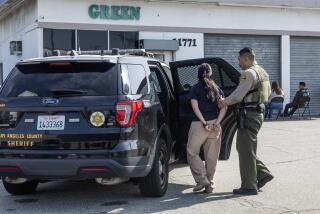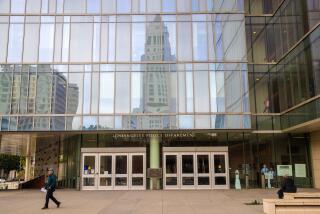Gang Detail Tackles Drug Problem : Arrests Up Sharply After Wilmington Residentsâ Protest
WILMINGTON â About 30 officers from a special division of the Los Angeles Police Department have been making dozens of arrests the past two weeks in two of the communityâs most drug-infested neighborhoods, police said.
The unusual deployment of officers in the Dana Strand Village housing project and in the East O Street area began four days after hundreds of Wilmington residents marched through the two neighborhoods to protest the growing narcotics traffic in the community, said Officer Phil Shattuck, who oversees the deployment.
Demonstrators had said they hoped to attract the attention of city officials and get more police officers in the two neighborhoods. Harbor Division officers regularly patrol the area, but police say they have too few officers to make a dent in the heavy drug trade.
âThe street sales continue, but maybe this shows these guys that the police mean business,â said Abelardo de la Pena Jr., an organizer of the demonstrations. âWe made some noise, and things are improving.â
Metro Gang Detail
The officers are part of the Metropolitan Divisionâs gang detail, a pool of officers that moves around the city to neighborhoods particularly hard-hit by gangs. Unlike the cityâs other 18 police divisions, the 196-officer Metropolitan Division has no geographic territory. Instead it acts as a mobile strike force in high-crime areas.
Shattuck said police believe that drug sales in Wilmington are gang-related, and he said most of the arrests the past two weeks have involved narcotics. Officers have been making about 10 arrests a day, but exact numbers will not be available until the deployment ends, he said.
The departmentâs most recent crime statistics show that the harbor area ranks fourth of the cityâs 18 divisions in the number of gang-related crimes. During the first seven months of this year, there were 300 such crimes in the Harbor Division, Shattuck said, including several murders.
âWe didnât really go in there for the narcotics problem,â Shattuck said. âWe went in there for the gangs. But the gang members are smart enough to know that narcotics are very lucrative, and they are users themselves.â
Marches Credited
Members of the Wilmington Home Owners, the group that organized the marches on Aug. 9, first heard of the special deployment at a meeting last week. Harbor Division narcotics Detective Stan Chavez told the group that the demonstrations were responsible for the stepped-up enforcement.
âYour marching did the trick,â Chavez said. âThe squeaky wheel gets the grease.â
In order to ensure the most effective enforcement, police will not say how long the Metropolitan Division officers will remain in Wilmington. Similar crackdowns in other areas of the city have lasted about a month, Shattuck said, with officers returning to the areas sporadically âto keep people guessing.â
âWe look at it on a weekly basis,â Shattuck said.
Long-Term Strategy
Police and residents acknowledge that, at best, the crackdown will stem the flow of drugs for only a short time. Nonetheless, the enforcement effort, they say, plays an important role in a long-term strategy to stamp out drug sales.
âHopefully, it will serve as a deterrent primarily to the buyers coming into Wilmington from out of town,â De La Pena said. âBut we know that this is just the first effort.â
Residents have also written letters to local, state and national officials asking for assistance, and members of the homeowners group voted last week to open discussions with the Guardian Angels, a volunteer anti-crime group that patrols high-crime areas, about organizing a chapter in Wilmington. Some members have also talked about hiring a private security firm to patrol residential streets.
While the number of crimes in the harbor area is about average for the city of Los Angeles, police said the area is feeling overwhelmed by its drug problems because it is experiencing one of the fastest crime-rate increases in the city, and many of the crimes are visible and violent.
Numbers Not Whole Story
âSometimes numbers themselves are not real indicative of what the problems are,â said Detective Connie Dial of the Police Departmentâs Narcotics Division. âIn one area you might have a house filled with armed drug dealers, compared to a guy who is selling drugs and riding his Porsche in the Hollywood Hills. There are problems, and then there are problems.â
During the first six months of this year, the Harbor Division--which includes Wilmington, San Pedro and Harbor City--experienced the largest increase in the city in so-called ârepressible crimes.â Those crimes, which include burglary, robbery and car theft, jumped 30% over the same period last year, police said.
Narcotics arrests in the Harbor Division jumped 50% during the same period, from 611 arrests during the first six months of 1985 to 919 this year, police said. Although separate statistics for Wilmington are not available, Harbor Division Capt. Dennis Conte said the vast majority of the narcotics arrests are made in Wilmington.
Harbor Division detectives said the sharp increases in narcotics arrests and repressible crimes were not coincidental.
Most Are âDope-Relatedâ
âAbout 80% of our burglaries are dope-related, 70% of our robberies are dope-related and about 50% of our homicides are dope-related,â said Lt. Mike Markulis, commanding officer of the Harbor Division detectives. Typically, drug users--especially the growing number of rock cocaine users--commit the crimes in search of money to support their habit, he said.
Overall, crime in the harbor area increased 16.3% during the first six months of this year compared to the same period last year, police said. The jump was the third-highest in the cityâs 18 police divisions, surpassed only by the 77th Street and Southeast divisions, which are traditionally high-crime areas, police said.
Citywide, crime went up 7.1% over the same period, an increase Police Department analysts attributed largely to a new state law that requires officers to report all incidents of domestic violence and make arrests. In the Harbor Division, however, detectives blamed their 16.3% increase on drug trafficking--particularly in areas like East O Street and Dana Strand Village.
More to Read
Sign up for Essential California
The most important California stories and recommendations in your inbox every morning.
You may occasionally receive promotional content from the Los Angeles Times.










